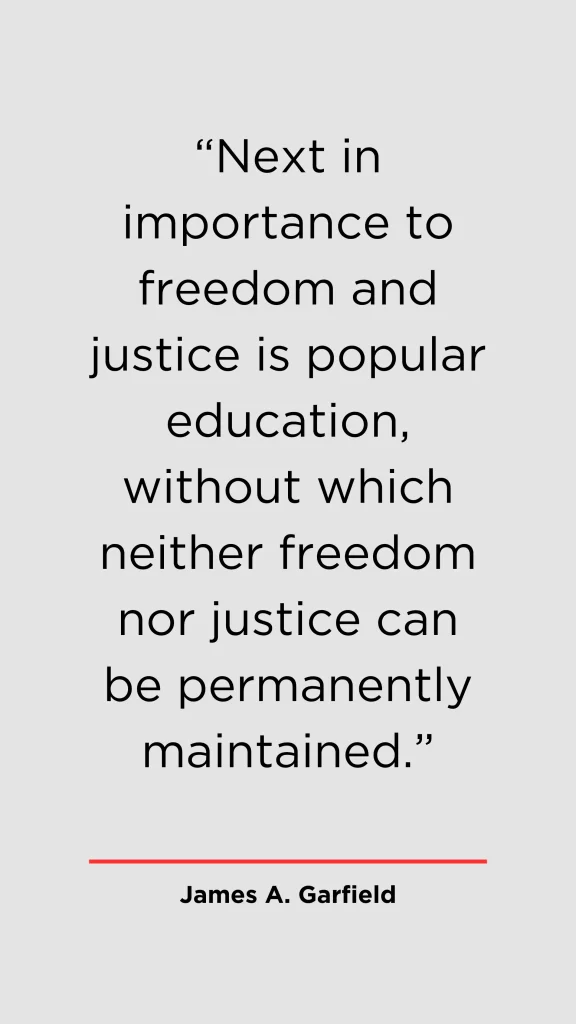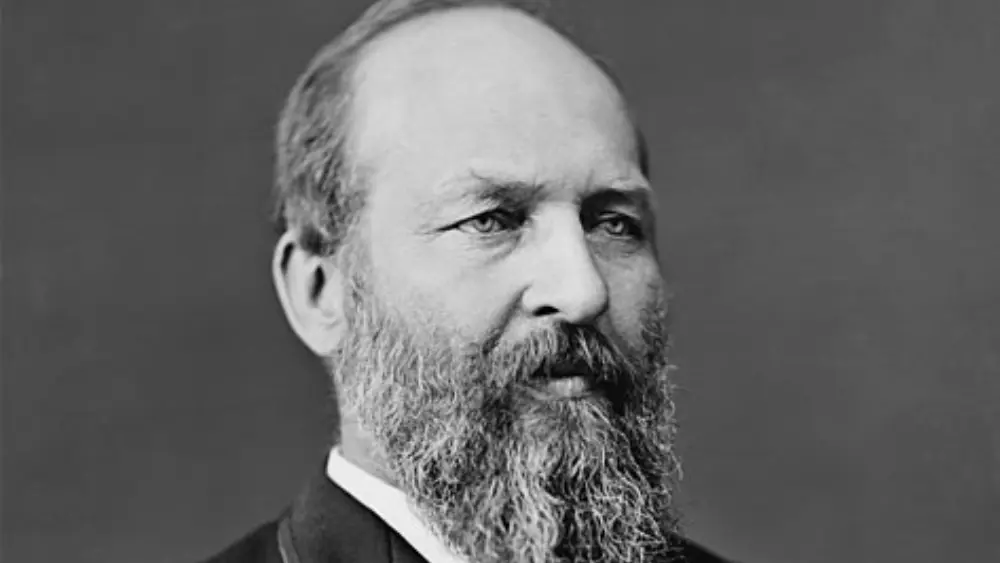James Abram Garfield, the 20th President of the United States, embarked on a remarkable journey from humble beginnings to the highest office in the land. Born on November 19, 1831, in a log cabin in Orange Township, Ohio, Garfield dedicated his life to education, military service, and public service.
Early Life and Education
James A. Garfield’s early life and education provide a remarkable testament to his determination and intellectual curiosity. Born on a humble Ohio farm, Garfield faced the challenges of rural life and limited resources. However, he demonstrated a remarkable thirst for knowledge from a young age. Despite the hardships, he diligently worked his way through school, displaying an unwavering commitment to self-improvement. Garfield’s relentless pursuit of education eventually led him to Williams College, where he continued to excel academically. His journey from a modest farm to a prestigious institution of higher learning exemplifies the American spirit of upward mobility through education, a theme that would continue to define his life and career.
Garfield’s early experiences laid the foundation for his later achievements in academia and politics. His ability to overcome adversity and prioritize education not only shaped his own path but also served as an inspiration to others. Garfield’s story is a testament to the transformative power of education, illustrating how it can lift individuals from humble beginnings to positions of leadership and influence in society. His commitment to learning and self-improvement would ultimately propel him into a distinguished career as a military leader, scholar, and, ultimately, the 20th President of the United States.
James A. Garfield: Republican Presidential Nominee
In 1880, the Republican Party found itself in a unique and somewhat unexpected position when they nominated James A. Garfield as their presidential candidate. Garfield, a seasoned politician and military leader, didn’t actively pursue the nomination but found himself in the spotlight because a contentious and deadlocked convention thrust him into the forefront. His unexpected nomination reflected the party’s desire for a compromise candidate who could bridge the divisions within the party at the time. Despite the initial surprise, Garfield ran a spirited and successful campaign, ultimately securing a narrow victory against the Democratic nominee, Winfield Scott Hancock. Garfield’s ascent to the presidency not only showcased his political acumen but also highlighted the ever-changing dynamics of American politics, where unexpected candidates can emerge as leaders and shape the course of the nation’s history.
James A. Garfield’s presidency, though tragically cut short by assassination, left a lasting legacy in American politics. His nomination and election in 1880 demonstrated the importance of party unity and the ability to appeal to a broad spectrum of voters. His unexpected rise to the presidency served as a reminder that in American democracy, candidates can emerge from unexpected places and moments, making it a dynamic and ever-evolving system. Garfield’s tenure as the 20th President of the United States showcased his commitment to civil service reform and his dedication to the betterment of the nation, making him a memorable figure in American political history.
Presidential Challenges
A multitude of significant challenges tested James A. Garfield’s leadership and resolve during his presidency. One of the most prominent challenges he faced was the factionalism within his own Republican Party. In the late 19th century, the Republican Party experienced deep divisions between two main factions: the Stalwarts, led by Senator Roscoe Conkling, and the Half-Breeds, who advocated for reform. Garfield’s nomination as the Republican candidate in 1880 was a result of a delicate balancing act, as he sought to appease both factions to secure the nomination. However, this fragile unity proved challenging to maintain once he assumed office. The factional infighting continued, hindering Garfield’s ability to implement his policy agenda and complicating efforts to address pressing national issues.
Another significant challenge that Garfield faced during his presidency was the need for federal government reform. The issue of civil service reform was at the forefront of his agenda, and he made efforts to promote merit-based appointments in the federal bureaucracy. Those who benefited from the patronage system, where government jobs were often awarded based on political connections rather than qualifications, resisted Garfield’s push for reform. Despite the obstacles, Garfield’s commitment to reform was unwavering, and he worked tirelessly to enact changes that would professionalize and depoliticize the federal workforce. Tragically, an assassin cut short his presidency in 1881, and he did not have the opportunity to fully realize many of his reform initiatives. Nonetheless, American political history continues to remember his legacy as a reformer and his efforts to confront the challenges of factionalism within his party as important chapters.
James A. Garfield: Assassination and Tragic Death
James A. Garfield’s presidency was tragically cut short by one of the darkest moments in American history. Just months into his term, on July 2, 1881, Garfield was shot by an assassin named Charles J. Guiteau. The motive behind the assassination attempt was rooted in Guiteau’s delusional belief that he was owed a government job and that by removing Garfield, he would facilitate the appointment of his preferred candidate. The shooting left Garfield critically wounded, and he endured months of excruciating pain as doctors struggled to locate the bullet inside his body. Despite the valiant efforts of the medical team, Garfield’s condition deteriorated, and he ultimately succumbed to his injuries on September 19, 1881.
Garfield’s assassination and tragic death underscored the urgent need for civil service reform in the United States, as the patronage system had allowed individuals like Guiteau to believe they were entitled to government positions through political connections. Garfield’s untimely demise also highlighted the vulnerability of political leaders to acts of violence, prompting increased security measures for presidents and government officials. His legacy as a reformer and his courage in the face of adversity continue to be remembered, serving as a reminder of the complex and sometimes perilous nature of American politics, with his life and tragic death.

Legacy and Impact
James A. Garfield’s legacy is a testament to his enduring commitment to several pivotal causes in American history. His dedication to civil rights, civil service reform, and education left an indelible mark on the nation. As a champion of civil rights, Garfield advocated for the protection and advancement of African Americans’ rights in the post-Civil War era, recognizing the importance of equal opportunity and freedom for all citizens. His push for civil service reform sought to depoliticize the federal bureaucracy, paving the way for a more efficient and merit-based government workforce. Additionally, Garfield’s passion for education was evident in his own journey from a humble Ohio farm to the presidency. He believed that education was a pathway to upward mobility and personal improvement, and his efforts to promote educational opportunities for all Americans remain a significant part of his legacy.
Garfield’s assassination tragically cut short his presidency, but his enduring impact on the nation’s history symbolizes principled leadership and dedication to progressive ideals. His legacy continues to inspire those who value civil rights, government efficiency, and education as vital components of a just and prosperous society. Garfield’s life and the causes he championed serve as a reminder of the enduring importance of individuals who strive for positive change and equality in the United States.




